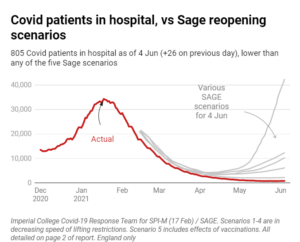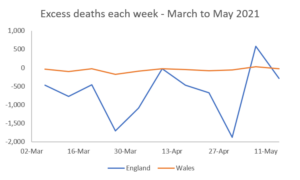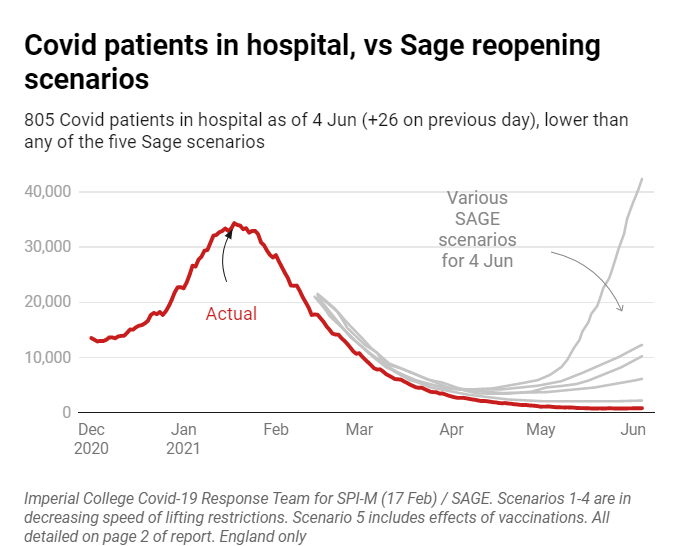10 June 2021
Lies, Damned Lies and Coronavirus
It’s all Greek to me
by David Chilvers
 This week we have seen the Indian Variant, now known as the Delta variant, become the dominant strain of Coronavirus in the UK. It still, however, seems to be concentrated in a relatively small number of areas in the North West of England and does not seem to be generating exponential growth elsewhere (or even in the North West for that matter). Portugal has been moved from the green country list to the amber country list, partly due to concern about the Nepal variant (presumably shortly to be re-classified as the Epsilon variant, although looking at the Gisead website, which is the authoritative source of data on variants around the world, it seems that a variant from California already has taken that slot and another variant from the UK and Nigeria has taken the Eta slot today).
This week we have seen the Indian Variant, now known as the Delta variant, become the dominant strain of Coronavirus in the UK. It still, however, seems to be concentrated in a relatively small number of areas in the North West of England and does not seem to be generating exponential growth elsewhere (or even in the North West for that matter). Portugal has been moved from the green country list to the amber country list, partly due to concern about the Nepal variant (presumably shortly to be re-classified as the Epsilon variant, although looking at the Gisead website, which is the authoritative source of data on variants around the world, it seems that a variant from California already has taken that slot and another variant from the UK and Nigeria has taken the Eta slot today).
In an exciting development, The Shaw Sheet can reveal the emergence of the Outer Mongolian variant, discovered amongst nomadic tribesmen in the Gobi Desert, and, given the speed at which new variants are appearing, likely to be reclassified as the Omega variant. This will doubtless be shortened to the OMG variant – as in Oh My God, we’ve reached the end of the Greek alphabet, what do we do now? The solution, as every Excel user will know with Column AA coming after Column Z, will be to call the next variant the Alpha Alpha variant and then the Alpha Beta variant and so on. This nomenclature can take us to the Omega Omega variant, which will be the 600th on the list and then we will need to go to three letters of the Greek alphabet.
This all seems extremely silly and of course it is given that there have already been a large number of mutations of the virus, most of which cause us no concern whatsoever. Back in November last year, it was estimated there were 12,706 mutations and there will be many more by now. As Professor Sir John Bell, regius professor of medicine at Oxford University and a leading Covid vaccines expert has said, “if the UK scampers down the rabbit hole every time a new variant emerges, the nation will be huddled away for a long time”.
There needs to be a more rational and transparent approach to assessing each development. The Kent (sorry Alpha) variant was said to be much more transmissible and dangerous than the original virus present in the UK. In January this year Sir Patrick Vallance, the UK’s Chief Scientific Adviser, held a press conference to announce that the Kent variant appeared to have a mortality rate 30 per cent higher than previous variants. Less noticed, however, were studies that were later published in the Lancet which concluded that the Kent variant was actually no more deadly than previous variants.
Data analysed more recently in the Chelmsford hotspot for the Indian (sorry Delta) variant suggested that, although there were 27 households infected with this variant, there was no evidence of any rapid increase in the number of COVID-19 infections – the number of cases overall continued to stay very low in spite of the number of cases of the Indian (sorry Delta) variant. 17 people were admitted to hospital in the entire Mid and South Essex area in May (covers Chelmsford, Basildon and Southend), with none since 21st May. There have been no COVID deaths in Chelmsford since 14th April and before that 14th March – so two deaths in the best part of three months.
Nationally, the South African (sorry Beta) and Brazilian (sorry Gamma) variants caused great concern when there were originally announced but have not become dominant strains in the UK. Far from it, they appear to have quietly disappeared from the scene. According to the UK genome sequencing analysis, as at 19 May, the number of each variant detected through genomic sequencing in the UK was as follows:
| Variant | Lineage | Country where detected | Total cases | Cases in past week |
| VOC-20DEC-01 | B.1.1.7 | England, UK | 249,637 | 7,066 |
| VOC-20DEC-02 | 501Y.V2 B 1..351 | South Africa | 904 | 41 |
| VUI-21JAN-01 | P.2 | Brazil | 60 | 0 |
| VOC-21APR-02 | B.1.617.2 | India | 3,424 | 2,111 |
And although since 19th May the Indian (sorry Delta) variant has become the dominant variant, the growth in hospitalisations is still quite small and entirely consistent with the additional social interaction that recent relaxation of restrictions has allowed and the impact of the vaccination campaign in reducing the number of cases that go on to be serious. What grounds are there therefore to assume that the Delta, Epsilon, Eta and indeed the Omega variant will overwhelm the NHS and cause another huge wave as predicted by the now surely discredited Imperial modelling?

This chart, reproduced from the Spectator coronavirus dashboard, shows that the numbers of people in hospital were lower than even the most optimistic of the five Imperial scenarios produced for SAGE, with the actual number of 805 patients in hospital in England on June 4th compared to over 40,000 in the most pessimistic scenario. And these forecasts were made before the emergence of the Indian (sorry Delta) variant. All forecasts are, by definition, wrong, but these are so wrong as to make you wonder about the assumptions made and the modelling process used.
In another development, again not highlighted much in the mainstream press, excess deaths continue to decline.

We noted a couple of weeks ago that the statistics on the number of COVID deaths as measured in different ways were becoming out of kilter. Negative excess deaths each week since mid-March are reducing the estimated COVID deaths from this source, whilst those from the other two sources (hospital data and data from death certificates) are continuing to increase (as arithmetically they must). Here is the data to week ending 21st May (the latest available for excess deaths in England and Wales):
| Cumulative to week ending 21-May | England | Wales |
| Deaths within 28 days of a positive test | 112,360 | 5,567 |
| Death certificate by date of death | 132,080 | 7,883 |
| Excess deaths | 99,935 | 4,909 |
| Cumulative to week ending 23-Apr | England | Wales |
| Deaths within 28 days of a positive test | 112,143 | 5,549 |
| Death certificate by date of death | 131,722 | 7,866 |
| Excess deaths | 102,193 | 5,055 |
| Change 23-Apr to 21-May | England | Wales |
| Deaths within 28 days of a positive test | 217 | 18 |
| Death certificate by date of death | 358 | 17 |
| Excess deaths | -2,258 | -146 |
In the last four weeks, the number of deaths within 28 days of a positive test has been 217 in England and 18 in Wales. The numbers on death certificates have been higher in England at 358 and 17 in Wales. The number of excess deaths has been -2,258 in England and -146 in Wales. So, the estimated COVID deaths from the most reliable source – excess deaths – continues to decline. And as we have noted before, this estimate will be an overstatement of about 15,000 deaths in England alone, as it uses a simple average of the past five years to calculate the baseline expected deaths rather than incorporating the upward trend in the number of deaths which has been apparent for the past ten years or so, due to the impact of the baby boomer generation.
Variants come and go, as they will with any virus; that’s why the flu jab is slightly different each year, to take account of the current dominant strain from other parts of the world. There is now no evidence that the Kent (sorry Alpha) variant is more threatening in terms of mortality, although the mainstream media has neglected to tell us that. All the evidence around the Indian (sorry Delta) variant is that it remains concentrated into a relatively small number of local areas and even in hotspots such as Chelmsford the number of cases has not suddenly accelerated. The preferred measure of mortality continues to decline and is over-stated anyway, with deaths occurring in the first and second wave bringing forward deaths that would have happened a few months later. Yet the media hype continues, with every new variant seen as a reason to continue to be fearful and stay locked away. It will be interesting to see if any of the other media pick up on the Outer Mongolian (sorry Omega) variant and realise that although it’s not April 1st, it’s a close call.
This article is one of a series, last week’s article on the roadmap/roadblock dilemma is here.


